On the first morning we drew Ivan Truong & Andrew Fergus for our initial game. The morning actually got off to a slow start with some fluffing around, and all 4 games being played in the first round probably lost about 20-30 minutes of game time, plus took excessively long to do terrain placement and deploy. Once underway Caesennius, the Roman C-in-C, soon managed to invade Germany for whatever reasons, we presume in the South-East perhaps? Anyhow, Caesennius managed to encamp on the edge of a German plain forcing the Cimbri to pitch tents in an area of poor terrain that was mostly Marsh (3 features of such in the German deployment area), while the Roman’s deployed on the adjacent open plain – but perhaps the Germans preferred being amongst the wet boggy muck and the joke was on Caesennius?!
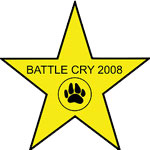 Regardless the Cimbri had, it appeared, been very industrious as they had fortified part of their camp in the Roman style with a palisade and ditch, and at sun up the weather came out clear and fine and the Romans found a surprising small force arrayed against them. On their left, opposite half of their heavy foot & auxilia was a force of Tigurini Allies from Gaul, mostly Wb(O) deployed in an area of Marsh but supported by a few Cv(O) Chariots & Cavalry and some Psiloi on their flanks. In the centre the Romans had their Armenian Allies, facing a smallish force of German Cavalry, and next, to the centre-right the Romans had the balance of their Legionaries & Auxilia facing some more Cavalry and a large empty area of Marsh. The Roman Cavalry and Artillery was deployed behind the main line to the right, and the balance of the Cimbri’s force was nowhere to be seen…
Regardless the Cimbri had, it appeared, been very industrious as they had fortified part of their camp in the Roman style with a palisade and ditch, and at sun up the weather came out clear and fine and the Romans found a surprising small force arrayed against them. On their left, opposite half of their heavy foot & auxilia was a force of Tigurini Allies from Gaul, mostly Wb(O) deployed in an area of Marsh but supported by a few Cv(O) Chariots & Cavalry and some Psiloi on their flanks. In the centre the Romans had their Armenian Allies, facing a smallish force of German Cavalry, and next, to the centre-right the Romans had the balance of their Legionaries & Auxilia facing some more Cavalry and a large empty area of Marsh. The Roman Cavalry and Artillery was deployed behind the main line to the right, and the balance of the Cimbri’s force was nowhere to be seen…
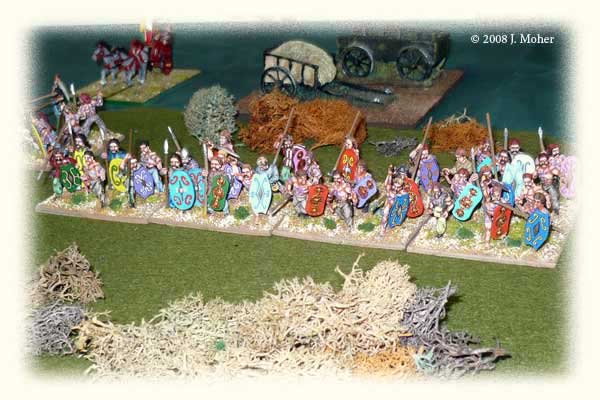
The Roman dispositions were designed to allow an aggressive advance towards the visible enemy forces while providing for a rapid response to the possibility of a flank march on the right – which seemed a likely event even before the German deployment had disclosed their lack of forces in the main position. The Cimbri then produced their first Stratagem – Delayed Battle – delaying the start by about 2 hours (until 0800) and increasing the likelihood of any flank march arriving… And then the battle was under way – the Cimbri were very restrained and showed no real desire to advance on the Romans, and Caesennius, in a fit of activity, responded by a rapid advance of the Roman line forward, rapidly closing the gap. On the right a column of Auxilia at the end of the line pulled ahead and headed into the large Marsh there, expecting to occupy it and threaten the enemy camp, but only to be surprised by the second Cimbri Stratagem – Ambushers – of which 2 groups totalling 16 Ps(O) & (I) were in the Marsh. They got the drop on the Romans initially and only the superior fighting power of the Auxilia kept them out of trouble and avoided envelopment – their being a brief squabble in the edge of the Marsh, with both sides taking minor casualties, before events elsewhere drew the Roman auxiliaries away to more pressing matters.
In the centre and on the left the Romans attempted to close and managed to engage minor elements of the Cimbri and Tigurini in that area, but as these were primarily Cavalry they were difficult to tie down to a decisive fight.
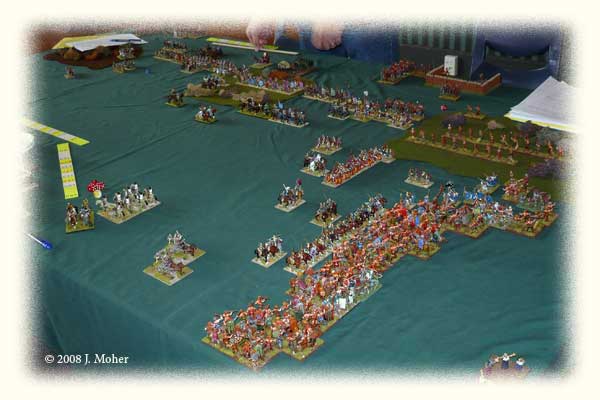
After a few bounds the expected Cimbri flank march arrived, as expected on the Roman right, but what wasn’t expected was that it was 45ME including 69 Warband(O) plus a few (7) Psiloi(I), and 2 Baggage! You can get a feel for the size in the photos above and below – it would need 31 Wb(O) to be eliminated to break the command! While the Roman Legionaries on the left and the Armenians supported by a few Legionaries from the right continued to press frontally against the thin Cimbri & Tigurini Cavalry line, the balance of the right Command turned to face the flanking force, the Auxilia in the Marsh disengaging and supported by the remaining uncommitted Auxilia & Psiloi (Archers) on the right, delayed, and then attacked the end of the Warband mass closest to the Marsh, buying time for the Legionaries beyond them to turn around and provide a solid front facing part of the Warband’s advance.
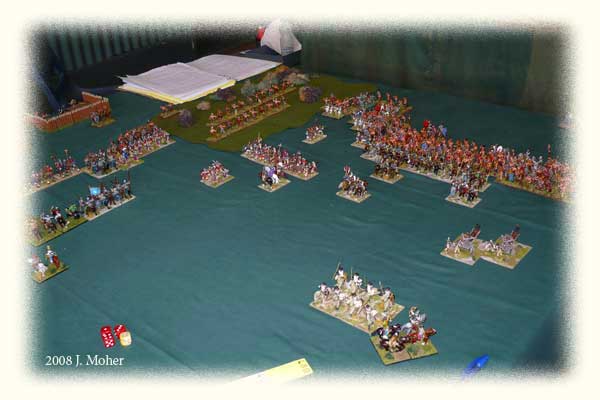
The Roman Cavalry had also already partially redeployed facing that flank in expectation so moved forward, and shook out into line to support the Auxilia and delay the bulk of the Cimbri force. At the far end, closest to the Roman baseline, the Art(F) Scorpions on Carts redeployed and began engaging the Warband at extreme range… The latter proved surprising effective, causing some recoils and eventually killing an element before a rapid withdrawal was called for, one cart at a time though, as they continued to fire on the Germans!
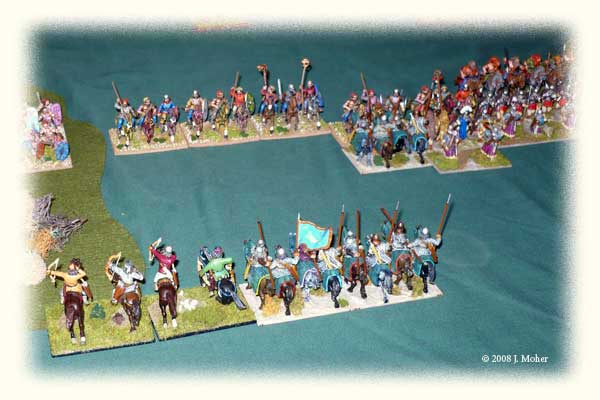
The Roman Auxiliaries were able to gradually increase pressure on the end of the line of Warband – despite being out numbered and losing one of their number they managed to significantly delay a portion of the Warband, turning the flank of some and generally disorganising them while even inflicting a casualty or two (see the photo below – top right). Meanwhile the Roman Cavalry, led by their General, now engaged and successfully attacked the Warband, slowing them, and inflicting a couple of casualties with no loss to themselves.
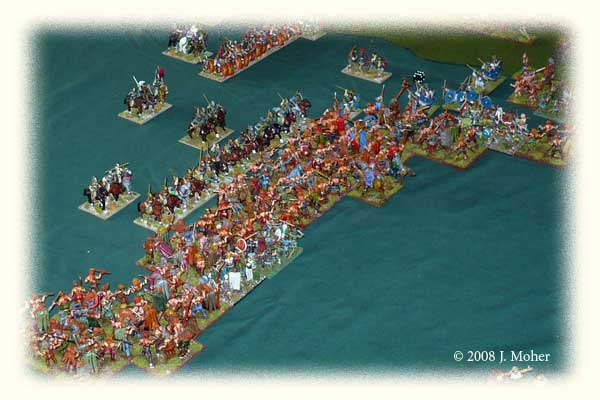
The Roman left & centre also continued to press forward, pushing the German & Gallic Cavalry back slowly towards their camp and occasionally inflicting casualties. On the Roman right the Cavalry, Art(F), and Auxilia were so successful that they delayed the flank march force significantly while inflicting several casualties. About a quarter of the Warband finally began to break through next to the Roman baseline, pursuing the retiring Art(F), but help was close by as the Numidian Cavalry of 4 x LH(O) and a couple of Armenian LH(F) Horse Archers had arrived behind the Artillery to take over that area and cover the Roman Baggage Camp.
And then time was called – although the huge mass of Warband was slowly bearing down on the Romans, they still held an advantage, having slowly whittled away casualties on the Germans, and it ended a Draw in the Roman’s favour 14-11. Neither side had had a command break and while the Romans had not lost 10% of their force yet the Germans had.
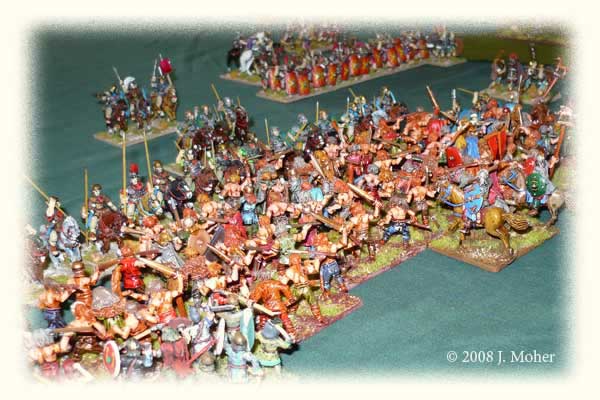
It’ll be remembered that some time was lost in this first round and another 30 minutes may well have produced one or both of two events, namely (1) the breaking of 1 or 2 of the small German Commands or Tigurini Allies near the baggage camp, and/or (2) the gradual advance of the mass of Warband on the right eventually overwhelming the Roman Auxilia on one side and threatening the Roman Camp on the other, while the Roman Cavalry was forced to give ground in the middle (it being unlikely the Roman’s could inflict casualties fast enough to threaten this command in just 30 minutes). If the Roman’s managed to break all the other commands they had a small chance of breaking the army; otherwise they still needed about another 23-24 Warband from the main mass!
On the other side of the coin the Germans were struggling to defeat the Roman Cavalry without turning their flanks and although applying pressure progress was slow for what was their decisive movement. The extra-time quite probably would have still brought a draw but possibly a small way further in the Roman’s favour (the Roman’s suffering 10% losses but possibly breaking 2 of the small German commands, which would have produced a 15-10 draw for what it’s worth), although a fight to the inevitable conclusion could well have just as easily seen a Germanic victory as a Roman one!
As the German C-in-C observed after the game, “the Roman Cavalry and Auxiliaries were surprisingly effective at combating and delaying the Warband!“. And as a couple of observers noted, flank marching such a large formation may not actually be the best of ideas as too much of the German’s main combat force was effectively rendered impotent for too long early in the battle.
Continue to BC’08 Round 2: Kushite Egyptians 700BC.

2 thoughts on “BC’08 Round 1: Early German Cimbri & Tigurini Gallic Allies 102BC”